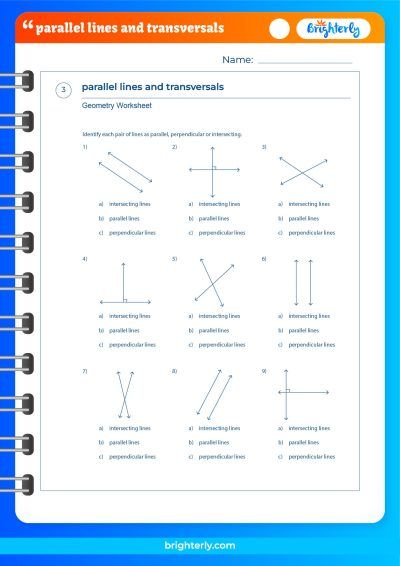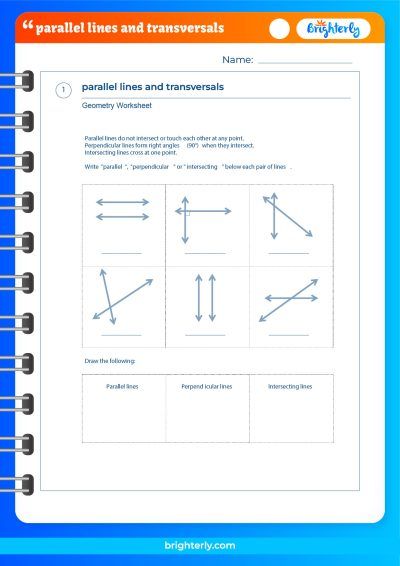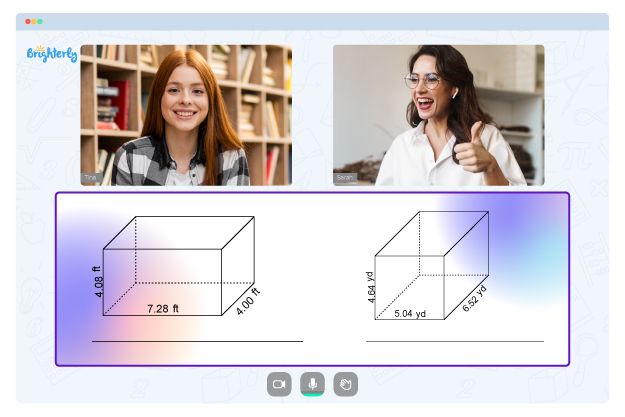Parallel Lines – Definition, Examples, Facts
Updated on January 11, 2024
Welcome to the enchanting world of parallel lines! At Brighterly, we strive to make math enjoyable and relatable. Parallel lines are not only significant mathematical concepts but are also deeply ingrained in our day-to-day lives. In this comprehensive article, we’ll venture into the realm of parallel lines, exploring their axioms, theorems, equations, and more. We’ll also delve into the intriguing idea of transversals and their connection with parallel lines. Furthermore, we’ll offer you solved examples, practice problems, and frequently asked questions to enhance your understanding of parallel lines. So gear up and join us as we unravel the captivating universe of parallel lines!
What are Parallel Lines?
In the fascinating world of geometry, parallel lines are lines that never intersect or cross each other, implying that they remain equidistant throughout their entire length. This constant distance between them is known as the perpendicular distance. Parallel lines are ubiquitous in our surroundings, from the ever-parallel train tracks to the neatly aligned edges of a notebook. These lines play a crucial role in numerous mathematical concepts and real-life applications.
Parallel Lines Axioms and Theorems
Geometry is full of intriguing axioms and theorems that help us gain a deeper understanding of parallel lines. Here are some of the most significant ones:
-
Euclid’s Fifth Postulate: Also known as the “Parallel Postulate,” it states that if a straight line intersects two other straight lines, causing the interior angles on the same side to be less than two right angles, these two straight lines will eventually meet on the side where the angles are smaller than two right angles.
-
The Converse of the Corresponding Angles Postulate: This postulate affirms that if a transversal cuts two lines, resulting in congruent corresponding angles, then the lines are parallel.
-
The Converse of the Alternate Interior Angles Theorem: According to this theorem, if a transversal intersects two lines, producing congruent alternate interior angles, then the lines are parallel.
-
The Converse of the Same-Side Interior Angles Theorem: This theorem states that if a transversal cuts two lines, and the same-side interior angles are supplementary, then the lines are parallel.
These axioms and theorems lay the groundwork for comprehending the properties of parallel lines and their interplay with other geometric figures. As you explore the mesmerizing world of parallel lines with Brighterly, you’ll uncover more captivating concepts and develop a strong foundation in mathematics.
Parallel Lines Equation
In the captivating realm of coordinate geometry, the equation of a line in a two-dimensional coordinate system can be written in the form y = mx + b, where ‘m’ represents the slope and ‘b’ stands for the y-intercept. The intriguing characteristic of parallel lines is that they remain parallel only if their slopes are equal. In other words, if line 1 has a slope ‘m1’ and line 2 has a slope ‘m2’, then the lines are parallel if and only if m1 = m2. As you unravel the mysteries of parallel lines with Brighterly, you’ll discover the critical role slopes play in understanding the behavior of these lines.
Parallel Lines Symbol
The world of parallel lines is laden with exciting symbolism. The symbol used to denote parallel lines is “||”. For instance, if we have two lines ‘a’ and ‘b’ and we wish to express that they are parallel, we simply write a || b. This concise representation not only simplifies mathematical expressions but also adds an element of elegance to the already fascinating domain of parallel lines.
What Is a Transversal?
A transversal is a line that intersects two or more other lines, revealing some fascinating angle relationships. When a transversal intersects parallel lines, it gives rise to numerous angles with intriguing properties, which we will explore in the subsequent sections. Transversals play a vital role in understanding the complex world of parallel lines, offering unique insights into their geometric behavior.
Parallel Lines and Transversal
When a transversal intersects parallel lines, it creates several angles with unique relationships. Some of these relationships include:
- Corresponding angles: Angles in the same position on both lines are congruent.
- Alternate interior angles: Angles on opposite sides of the transversal and inside the parallel lines are congruent.
- Alternate exterior angles: Angles on opposite sides of the transversal and outside the parallel lines are congruent.
- Same-side interior angles: Angles on the same side of the transversal and inside the parallel lines are supplementary (i.e., their sum is 180 degrees).
- Same-side exterior angles: Angles on the same side of the transversal and outside the parallel lines are supplementary./
These angle relationships are essential in solving various geometry problems and proving theorems involving parallel lines and transversals.
As always, Brighterly is committed to offering top-notch math resources and engaging worksheets for kids, ensuring they grasp and practice the concepts they learn. With our fun and interactive lessons, we make math an enjoyable experience for children of all ages.
Parallel Lines Properties
Parallel lines have some interesting properties that make them unique. These properties include:
- Parallel lines never intersect.
- The perpendicular distance between parallel lines is constant.
- The slopes of parallel lines are equal.
- The angles formed by a transversal with parallel lines have unique relationships, as discussed earlier.
Parallel Line Equations
To find the equation of a line parallel to a given line, we need to ensure that the slopes of both lines are equal. If the given line has the equation y = mx + b1, and we want to find the equation of a parallel line that passes through the point (x1, y1), we can use the point-slope form:
y – y1 = m(x – x1)
Since the slopes are equal, we substitute the slope ‘m’ from the given line and solve for the new equation.
Solved Examples
Example 1: Find the equation of a line parallel to the line y = 2x + 3 and passing through the point (4, -1).
Solution: We know the slope of the given line is 2. Since the new line is parallel to the given line, its slope is also 2. Using the point-slope form:
y – (-1) = 2(x – 4)
y + 1 = 2x – 8
y = 2x – 9
Example 2: Determine whether the lines y = 3x + 2 and y = 3x – 4 are parallel.
Solution: The slopes of the two lines are both 3. Since their slopes are equal, the lines are parallel.
Practice Problems
- Find the equation of a line parallel to the line y = -4x + 6 and passing through the point (2, 5).
- Determine whether the lines y = (1/2)x + 3 and y = -2x – 1 are parallel.
- Find the value of x if the lines 3x – 4y = 12 and 6x + 8y = 10 are parallel.
Conclusion
Parallel lines hold a unique and irreplaceable position in geometry, significantly impacting various branches of mathematics and the world around us. As you embark on this exciting and transformative journey with Brighterly, unraveling the mysteries of parallel lines and grasping the properties, axioms, theorems, and equations associated with them will empower you to tackle a diverse range of geometry problems, fortifying your foundation in mathematics.
At Brighterly, our mission is to make learning a delightful experience. As you explore the captivating realm of parallel lines, you’ll not only develop a comprehensive understanding of these essential geometric entities but also uncover their hidden beauty, elegance, and the vital role they play in the mesmerizing world of mathematics.
Together with Brighterly, you’ll discover that parallel lines are not just simple geometric concepts, but rather, they are gateways to a vast and enchanting universe that stretches far beyond the confines of the classroom. So let’s embark on this awe-inspiring adventure and delve deeper into the enthralling world of parallel lines, where learning and fascination intertwine with the magic of mathematics.
Frequently Asked Questions on Parallel Lines
What are some real-life examples of parallel lines?
Some examples include train tracks, rows in a field, and lines on a notebook page.
Are all horizontal lines parallel?
Yes, all horizontal lines are parallel since they have the same slope, which is 0.
Can two lines be parallel and have different y-intercepts?
Yes, parallel lines can have different y-intercepts. The only requirement for two lines to be parallel is that they have the same slope.






